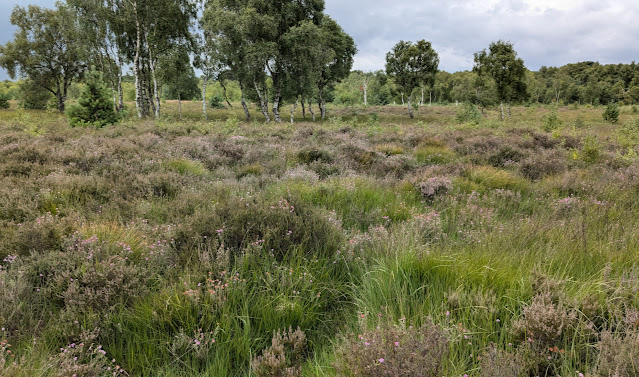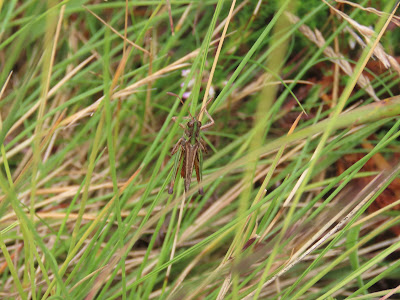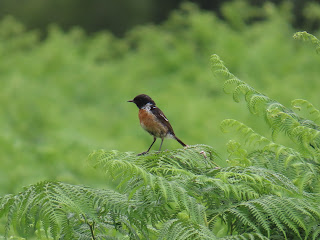My first visit to this large reserve, as a recce for our upcoming Bog Bush-cricket acoustic survey. Sarah and I arrive around 8:15. It is mostly overcast, with light cloud cover, and a brief light shower, but it is warm and humid, which means we get to see a lot of insects. Fortunately, the water level has subsided from what it sounded like a very flooded heath earlier in the year. There were only a couple of tricky spots to cross, and I managed the trip with (mostly) dry socks in my trainers. It was a quiet walk, with just a dog walker seen near the car park, and possibly two naturalists further into the reserve.
Strensall Common is a designated Special Area of Conservation (SAC) and SSSI. It is one of the largest areas of lowland heath in England, at 570 ha, and one of the best quality wet and dry heath sites in the UK. It has highly diverse habitas, with a mosaic of wet and dry heath, grassland, woodland, scrub, bogs and pools. The woodland is open and mostly pine and birch and there is a lot of natural regeneration of both, with a spread of tree ages, giving it a very natural woodland look, with plenty of heathland underneath. The site survival in such good condition stems from its military use, the MOD bought the common in 1884 for military training purposes. It is an active training site, and the area used for firing is fenced off and out of bounds during exercises, which was the case today. The area outside of this is still quite large, and that was our roughly circular route around the eastern side of the common.
One of the padlocked gates into the training area, closed to visitors today, hopefully we'll be able to visit in the future.
Round-leaved Sundew.
The habitat is managed with sheep and cattle grazing in summer and autumn. Species of conservation concern include Nightjar, Woodlark, Pillwort, Marsh Gentian, Pond Mud Snail and it is the only site in England for the Dark Bordered Beauty Moth.
Heath with naturally regenerating pine.
We start walking along a footpath towards the west of the car park and soon we see the first patch of wet heath, and it is not long until we find the first Bog Bush-cricket, a female late instar nymph, which bodes well for the day. The Cross-leaved Heath is plentiful and flowering, with many stems in bud, the extremely wet year has probably created ideal conditions for this species.
As we walk, we come across these rounded depressions with steps on the pea (photo above), indicating old manual peat cuttings. This is also the origin of several ponds and boggy areas in the reserve, together with tank ruts.
The Bog Bush-crickets
We end up counting 20 bog bush crickets, most found on or very close to Cross-leaved Heath, with Purple Moorgrass growing nearby, a few on a patch of lush Purple Moorgrass. We notice a sex bias towards females, with few males found. Adults, both males and females were already present, but there were areas with late instar nymphs. We follow a method of walking slowly amongst the heath, paying attention to any movement. The relatively still and not too warm conditions definitely help, with the bush-crickets more sluggish than otherwise they would have been and their movement more easy to spot.
Other Orthoptera
Strensall is a great Yorkshire site for Orthoptera, they are diverse and abundant. We recorded Common Green Grasshopper, Meadow Grasshopper, Mottled Grasshopper and Common Groundhopper, in addition to the Bog Bush-cricket.
Mottled Grasshopper.
Common Groundhopper.
Dragonflies and Damselflies
We recorded Common, Ruddy and Black Darter, Blue-tailed Damselfly, undetermined blue Damselfly and a Brown Hawker. I was quite pleased with the Black Darter, a species I don't often come across.
Male Black Darter
Other invertebrates
We recorded Green-veined White, Small and Large Skipper, Ringlet, Gatekeeper and Small Heath. A number of Funnel-web Spiders were seen, a species that appears to be expanding it's range northwards. One caught an unfortunate mottled grasshopper we disturbed. A Bog Hoverfly, Sericomya silentis, was seen, but was too fast for a photo. The weather conditions kept the number of biting insects low, so I am pleased to report two horsefly records and two mosquito bites, which is quite reasonable for this time of year.
A disappointing bird list, but probably normal given the time of year. Of note was a family of Stonechats near the car park.
More information



















No comments:
Post a Comment